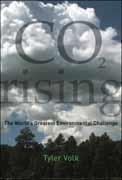William Bloss reviews this book aimed at the general reader
CO2 rising
Tyler Volk
Cambridge, Mass: MIT Press 2008 | Pp223 | £14.95 | ISBN 978 0 26 222083 5
Reviewed by William Bloss

In this book, Tyler Volk tackles the familiar topic of the greenhouse effect and climate change with a different focus. Aimed at the general reader with a modest scientific background, the first part of the book addresses the interlinked carbon cycling and fluxes between components of the biosphere - loosely, the atmosphere, oceans, soils and living organisms. This leads to the thorny issue of what fraction of emitted CO2 remains in the atmosphere, and over what timescales equilibria are established between the different reservoirs - a crucial issue overlooked in many simple accounts of climate change.
The author introduces this topic by following the fates of 'individual' carbon atoms, called (for example) Icille, Coalleen, Oiliver and Dave - the names of the first three reflecting the start of their 'stories' in an ice core, a coal field and an oil deposit. We follow the transformations through the biosphere of each carbon atom, detailed with anecdotes such as Dave's cycle through ethanol to CO2 via consumption of a glass of beer. Personal preference may determine if this approach is an annoying gimmick or an effective tool - I initially took the former view, but in retrospect it is an effective way of introducing many aspects of the carbon cycle, and their different magnitudes and timescales.
The second half of the book looks at trends in CO2, using a back-of-the-envelope approach to map economic growth trends to energy usage and CO2 emissions to average global temperatures, focusing on the period up to 2050 as a tangible timescale. Some of the challenges in reducing CO2 levels, such as international emission inequality and the effects of technological inertia, are briefly considered.
Overall, this a clear and well written book, which makes for an easy read. Although there is little chemical detail, the explanation of the complexities of the global carbon cycle is the book's strength.






No comments yet